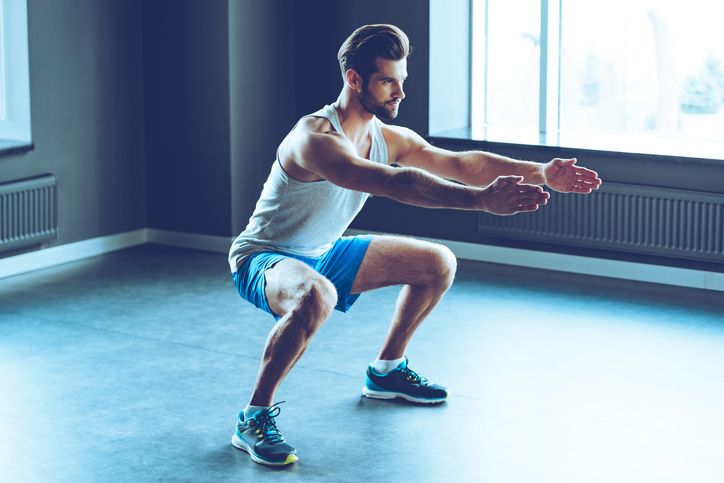Training
Articles
Squatting Myths That Won’t Go Away
by Poliquin Group™ Editorial Staff
6/13/2017 1:35:52 PM

Squats have enjoyed a renewed popularity in recent years as more and more people have discovered its many benefits. The squat works the large muscle groups that are key to making athletes stronger, more powerful and able to run faster and jump higher. It can help you build muscle, lose fat, and improve your quality of life. Nevertheless, there are many myths about the squat that still linger – here are 10 of them.
1. Squats increase knee laxity. In 1961 college professor Karl K. Klein and medical doctor Fred L. Allman, Jr. published a study suggesting that full squats – not parallel squats -- could increase knee laxity thereby increase the risk of knee injury. However, there were flaws in the study, the results could not be reproduced, and later studies found that those who performed full squats had more stable joints that other populations.
2. Squats wear out the joints. Can squats cause long-term damage to the knees or give you arthritis? To address this issue, consider that a paper published in Sports Medicine in 2013 looked at the risk of injury and degenerative conditions from performing deep squats. The researchers concluded, “Concerns about degenerative changes of the tendofemoral complex and the apparent higher risk for chondromalacia, osteoarthritis, and osteochondritis in deep squats are unfounded.”
3. Deadlifts are just as good as squats. The deadlift not only develops the major muscles of the lower body, but also many muscles of the upper body, such as the trapezius, and the grip. The downside of the deadlift is that it doesn’t work the legs through a large a range of motion, so the development of the quads and glutes is not as significant as they will be with squats. Rather than choosing between one or the other, include both squats and deadlifts in your program.
4. Squats will make you slow. “Speed kills” in sports, and there has been a concern among many coaches that over-emphasizing the squat will slow down athletes. Many research papers have disproved this myth, one example being “Increases in Lower-Body Strength Transfer Positively to Sprint Performance: A Systematic Review with Meta-Analysis.” This paper looked at 15 studies involving a total of 510 subjects, and 96 percent of the sprint test (50 our of 52) were less than 30 meters. The researchers concluded that “Increases in lower-body strength transfers to sprint performance.”
5. Pre-Exhaustion works the quads harder than squats alone. Pre-exhaustion is a training method introduced to the bodybuilding world by Robert Kennedy in 1968 and popularized by Nautilus Founder Arthur Jones. Jones believed that the limiting factor in developing the quads with squats was the strength of the lower back. As such, he recommended “pre-exhausting” the quads with leg extensions and legs presses before squatting. Nice try.
Research published in the May 2003 issue of the Journal of Strength and Conditioning Research found that post exhaustion (performing the primarily exercise first) is superior to pre-exhaustion. One reason is that by performing quad isolation movements first you will be forced to use a much lighter weight than you could otherwise, thus decreasing the intensity of the exercise.
6. Partial squats are better for improving vertical jump. Because you are stronger at the finish of a squat, it has been assumed that quarter squats with maximal weights are superior to full squats. Not true. A German study found that full squats are superior for quarter squats for improving vertical jump; the group that did full squats improved 8 percent and the quarter squat group showed no improvement.
7. Your knees should never extend over your toes during squats. The preponderance of research has shown that with few exceptions (such as pre-existing injuries), squatting so that your knees extend in front of your toes will not damage the knees. What is interesting is that those who recommend partial squats often recommend not allow the knees to go in front of the toes during lunges or split squats. Yes, you can restrict the amount the front leg goes forward, but what about the back leg? The start position of the split squat is the with the back knee in front of the back foot, and the movement forward in a lunge immediately causes the rear knee to travel in front of the rear foot.
8. Powerlifting squats are better for athletes that full squats. Those who promote powerlifting squats over full squats have strong arguments as to why their exercise is better for athletes. However, sports scientist Bud Charniga says methods that reduce the range of motion of the legs, including performing partial squats over full squats, may increase the risk of injury and adversely affect athletic performance. “When you combine taping/spatting of ankles, knees, applying braces, even stiffening shoes; stiffening of knees, hips, ankle joints, tendons and ligaments with powerlifting squats to parallel, bench squats, machine exercises and so forth; what will be the outcome? How will joints be able to bend naturally, proportionally, relative to each other; and, by how much?”
9. Squats damage young spines. A controversial study was introduced at the 2012 Annual Meeting of the North American Spine Society that suggested that squats could cause a pars interarticularis fracture. The problem with the study is that it primarily looked at the biomechanics of the exercise and did not involve any before-and-after methodology.
10. You don’t have to squat deep to work the glutes. If developing your glutes is a priority, you might be disappointed if you do not perform full squats. Research using EMGs has found that full squats are 100 percent more effective in activating the glutes than partial squats.
The squat has been a persecuted exercise over the past half century, but it has survived all the controversies caused by misinformation. Myths will always persist, but until someone comes up with evidence to prove otherwise, the squat is still the King of Lifts.
Copyright ©